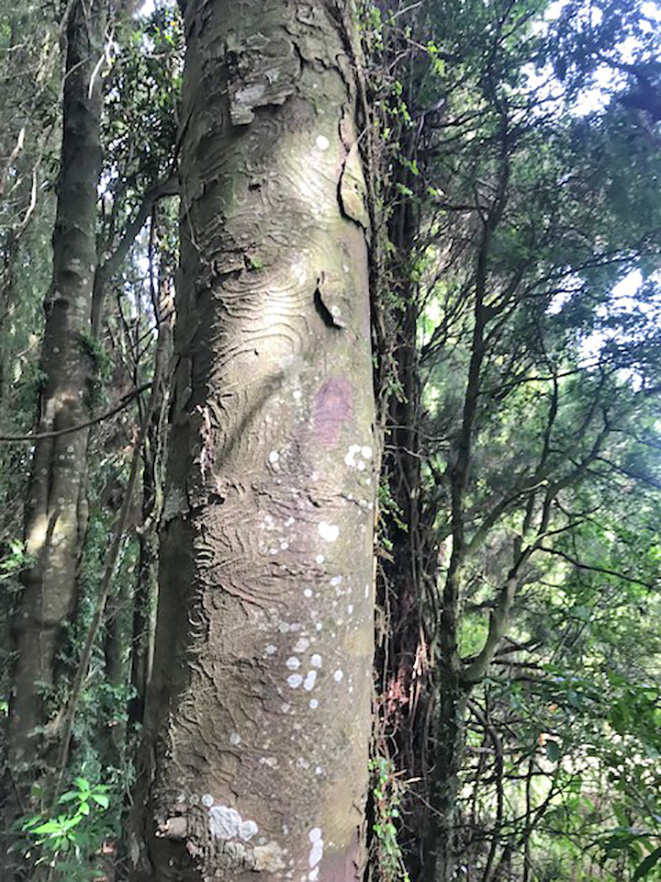Our ancient podocarps

FOOD SEED: Podocarp species with an interesting bark on trunk of a matai tree. Photo supplied
Contributed
Jo Bonner
Coastlands Plant Nursery
Aotearoa’s podocarps are very special. Found nowhere else in the world, they are part of a lineage that stretches back to when we were part of the super continent, Gondwana.
They are part of the coniferous family, have scale-like leaves and trees are either male, which have cones, or female, which have fruit (dioecious).
The name podocarp means “foot seed”, which refers to the way the seed is held in the bract or fruit, usually just one and at the foot of the fruit rather than enclosed by it. Our native birds love to eat these.
Often referred to as a “mast season”, podocarps have a seven-year mass seed-producing cycle. For this to occur, the temperatures and moisture levels need to be lined up to produce many seed.
Rimu is particularly sensitive to these changes; I have only ever seen one mast season for rimu here in the Bay, which happened in 2014.
The South Island had one in March this year. When we have an abundance of podocarp seeding, native bird life flourishes – birds such as tui, kaka, bellbird and kereru.

The other podocarps seem to follow a biennial seeding, with every second or third year heavier, although this fluctuates between trees and their own biological growth influences.
New Zealand has 15 different podocarp tree species, the most commonly known are rimu, totara, miro, kahikatea and matai.
Scattered podocarp forests throughout New Zealand are a rich source of plant species, insects, birds and animals, a tribute to their ancient past.
These forest types are found from Northland, to Coromandel, the Bay of Plenty, central North Island, Taranaki and the largest podocarp forests are on the West Coast of the South Island.
Locally, you can see a small pocket of podocarp forest up close at White Pine Bush Scenic Reserve. It’s well worth a visit just 10 minutes from Whakatāne, on White Pine Bush Road between Awakeri and Tāneatua. It’s a remnant kahikatea forest which would have covered the Rangitaiki Plains hundreds of years ago.
Whirinaki Te Pua-a-Tāne Conservation Park is a superb example of podocarp forest, a majestic rainforest right on our doorstep. Huge ancient trees are 500-700 years old, and the oldest more than 1000 years old. Well worth the hour drive.
The climate and soil types play a significant role in determining which species will be most dominant in a podocarp forest.
Widespread, and found closer to the coast in lowland forest, on sandy soils, and on the drier hillslopes, tōtara does well.
Tōtara (podocarpus totara) grow up to 30 metres tall, with massive trunks. They are great for hedging and shelter in windy areas as stock don’t like to eat the prickly leaves.
Miro and rimu grow well on inland slopes with more nutrients. Miro (Pectinopitys ferruginea) grow up to 25m tall, and bear crimson-purple fruit, especially in autumn to early winter, which is a favourite food of kākā and kereru and is produced at a time when there is less food available.
A common tree of lowland to montane forest, rimu (Dacrydium cupressinum) can reach up to 50m in height. They are found in the north and south, plus Stewart Island, from lowland areas to subalpine.
There are differences between the North and South Island rimu, with the South Island rimu requiring more moisture than the North Island type. It’s important to make sure you know the origin of ther podocarp species that you are purchasing as they need to bea climatised to the surroundings to survive.
In lowland forest areas where soil nutrient levels are rich, matai prevail. Often found in drier climates in which soils are waterlogged or flooded in winter and dry in the summer.
Matai (Prumnopitys taxifolia) is very slow growing, reaching 30m, a tree for the long term.
The round blue-black fruit is enjoyed by kākā and kereru.
Kahikatea grow well on sites that are wetter, where soils are peaty, in coastal swamps and stream margins. Kahikatea (Dacrycarpus dacrydioides), or white pine, is Aotearoa’s tallest native tree, reaching up to 60m high. Found throughout lowland areas, the kahikatea is one of the most reduced forest types in New Zealand, once dominating in lowland swamp areas.
Edible red fruits are popular with native birds; the round black seeds sit on the end of the fruits like tiny lights.
Some kahikatea can have a blueish leave colour in autumn, which is striking against the surrounding forest.
Also, when purchasing podocarpus, it’s important to know if they have been seed or cutting grown. Producing podocarps from cuttings produces a clone of the original tree, which can be good if you want to keep the genetics of the good timber tree or leaf colour variation.
The downside is if the cuttings are not taken from apical (upward growth) then they will be weak and lack vigour. Also, you are getting only male or female trees.
Producing podocarps from seed produces strong diverse trees and a good mix of male and female, providing a richer ecosystem.
